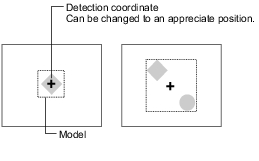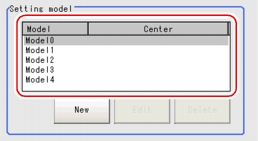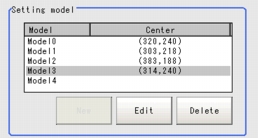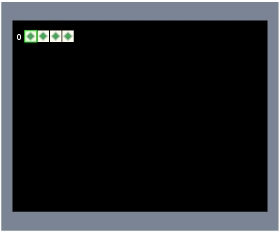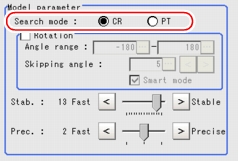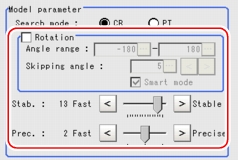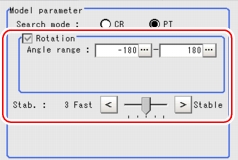[Model (Flexible Search)]
Register the parts to measure as the model.
Total 5 types of models ranging 0 to 4 can be registered, with no restriction on the size.
Total 5 types of models ranging 0 to 4 can be registered, with no restriction on the size.
Important
- When a model is registered, the central coordinates of the model are registered as the detection coordinates (if multiple figures are combined, the central coordinates of the circumscribed rectangle are registered). For this, ensure the position of the measurement object to be correct when registering a model.
- In the "Item tab" area, tap [Model].
- If necessary, set up the "Model parameter" area.
- In the "Setting model" area, select a model and tap [New].
- Specify a region to be registered as a model by using one of the Drawing tools.
- In the "Figure setting" area, tap [OK].
- To register two or more models, repeat the Steps 3 to 5.
Changing [Model Parameter]
When any settings have been changed, verify whether measurements can be performed correctly through actual measurement.
- For search operations, see
 User's Manual, "Configuring Search".
User's Manual, "Configuring Search".
- In the "Model parameter" area, select the search detection method and specify a value for each item.
Table: Model - Model Parameter This search mode detects areas with a high degree of shape similarity between the registered model image and the input image.
It is available only when 3 Mega pixel color camera is connected. User's Manual, "Configuring Search"
User's Manual, "Configuring Search"- If necessary, check "Rotation" and specify a value for each rotation item.How to input a value:
 User's Manual, "Inputting a Value"
User's Manual, "Inputting a Value" - The values for "Stab." and "Prec." can be specified by dragging the slider.
Table: Model - Model Parameter - PT - If necessary, specify a value for each item.How to input a value:
 User's Manual, "Inputting a Value"
User's Manual, "Inputting a Value" - The value for "Stab." can be specified by dragging the slider.
- If necessary, check "Rotation" and specify a value for each rotation item.
Points on Adjustment
For adjustments, see also  User's Manual, "Points on Adjustment".
User's Manual, "Points on Adjustment".
When measurement results are unstable
- If the model image consists of detailed figures, specify a larger value for "Stab.".
- If images that should be judged OK based on the model image vary in some degree, specify a smaller value for "Candidate LV".
- If the measurement results are unstable only when "Rotation" is selected, specify a smaller value for "Skipping angle".
- When "Rotation" is selected, if the model region shape is complex, uncheck the "Smart mode" option.
When the processing speed is slow
- If the model image is a simple figure or a large figure, specify a smaller value for "Stab.".
- If images that should be judged OK based on the model image, have less variation, specify a larger value for "Candidate LV".
- When "Rotation" is selected, if the model image is a simple figure, specify a larger value for "Skipping angle".
- When "Rotation" is selected, if the model region shape is simple, check the "Smart mode" option.
For other adjustment methods, see  User's Manual, "Shortening Measurement Time by Setting Processing Item".
User's Manual, "Shortening Measurement Time by Setting Processing Item".
For the following operations, see  Setting up [Flexible Search].
Setting up [Flexible Search].
